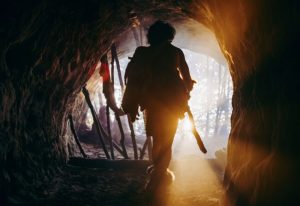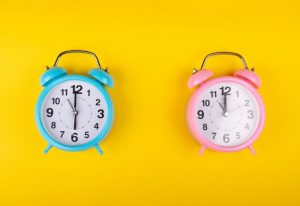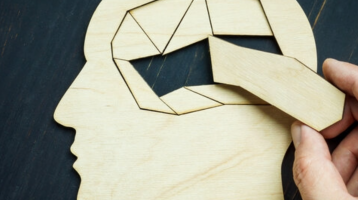The science surrounding chronotypes is interesting in and of itself. In recent years, we’ve learned that there are connections between chronotype and personality traits, mental health risks and overall physical health. However, recent science regarding the genetic component of chronotype take the scientific understanding of chronotypes to the next level, opening up the potential to glimpse the origin of chronotypes as well as to see their value in evolutionary terms.
Not only does chronotype vary between individuals, but it also varies within a single individual according to age, leading some researchers to theorize about the evolution of and security value of these variations in hunter-gatherer cultures.
Sleep, Wake and Activity Rhythm
 In the most basic sense of the word, chronotype describes a person’s natural sleep, wake and activity rhythm within the approximately 24-hour cycle that makes up a person’s circadian rhythm. The basic groupings are morningness, eveningness and intermediate. Due to its role in sleep timing, which can impact circadian rhythm, chronotype can impact physical and mental health in a variety of ways.
In the most basic sense of the word, chronotype describes a person’s natural sleep, wake and activity rhythm within the approximately 24-hour cycle that makes up a person’s circadian rhythm. The basic groupings are morningness, eveningness and intermediate. Due to its role in sleep timing, which can impact circadian rhythm, chronotype can impact physical and mental health in a variety of ways.
That is, in part, due to the role of the circadian rhythm in the timing of near countless complex bodily processes, such as the manufacture and release of essential hormones, including melatonin and insulin. Furthermore, disruptions in the circadian rhythm, sleep quantity and sleep quality, a common occurrence when chronotype and lifestyle are at odds, can also negatively impact health and well-being, increasing the risk of numerous diseases.
Chronotype Has Genetic Components
Modern science and technology has opened up vast research potentials, something that has greatly benefited the study of chronotypes. With the ability to conduct genome-wide association studies (GWAS) on a massive scale, scientists have been better able to confirm that chronotypes do have genetic components. There are identifiable genetic differences between the basic chronotype groups. For example, a genetic variation in the PERIOD2 (PER2) gene is linked to later chronotypes, as opposed to those that would fall into the morningness category.
A study based on the data of about 700,000 people, collected from 23andMe and the UK Biobank, found there to be 351 genetic variants at play in determining chronotype. This confirms and adds to earlier studies noting genetic variations, with the newer study revealing far more variations related to chronotype determination. Studies suggest that between 20 percent and 50 percent of the factors involved in determining chronotype are present at birth due to genetics.
Some of the genetic variations that influence chronotype occur in genes that have to do with the correct functioning of body clocks. Other chronotype-impacting gene variations were found in the genes associated with the retina and how it translates light into signals suitable for the brain. These are just a couple of the genetic variations linked to chronotype.
A Clue to Origin of Chronotypes
Evidence of a genetic component to chronotype opens up new avenues of thought when it comes to the origin of chronotypes. Viewed through an evolutionary perspective, there could be practical value associated with chronotype variation among individuals living in a group. As noted in a study published by the Proceedings of the Royal Society B: Biological Sciences, sleep can be a vulnerable, dangerous time for animals, including humans — particularly those in pre-industrial, non-urbanized, non-agrarian societies.
Thus, variations in chronotype that result in the group not all sleeping and waking at roughly the same time, but instead result in various members of the group being awake at different times throughout the night, could be a real benefit to the security of the group and even enhance survival rates. On the path of evolution, for the most part, those that survive have a better chance of passing on their genetic material.
 Interestingly, the international team of researchers involved in the study found that among the hunter-gatherer Hadza of Tanzania, all members of the group slept at the same time for just 18 minutes. The researchers observed the group for 20 days. According to the researchers, someone was awake 98.8 percent of the time. That means, in case of danger, someone was available to wake and warn the group for quite close to the entire night. The researchers explained that because of the similarities of the Hazda lifestyle to that of our ancestors in the Pleistocene period, it may be possible to glimpse some elements of our own evolutionary path.
Interestingly, the international team of researchers involved in the study found that among the hunter-gatherer Hadza of Tanzania, all members of the group slept at the same time for just 18 minutes. The researchers observed the group for 20 days. According to the researchers, someone was awake 98.8 percent of the time. That means, in case of danger, someone was available to wake and warn the group for quite close to the entire night. The researchers explained that because of the similarities of the Hazda lifestyle to that of our ancestors in the Pleistocene period, it may be possible to glimpse some elements of our own evolutionary path.
Work With Your Chronotype When Possible
In contemplating our evolutionary history, it is worth noting that how our bodies function is the result of thousands upon thousands of years of evolution. While we who live a modern lifestyle may feel as though we are far different from our Pleistocene ancestors or even from the Hazda, the amount of time that we’ve been living this lifestyle is just a moment in time when looking at the vast expanse of our history.
Those ancient rhythms still impact how our bodies function today. It makes sense, then, for better sleep and for better health to work with our chronotype, arranging our obligations and activities to fit better with our natural rhythms as much as possible.







